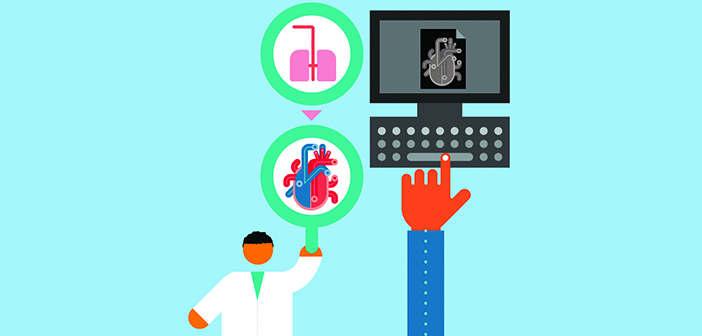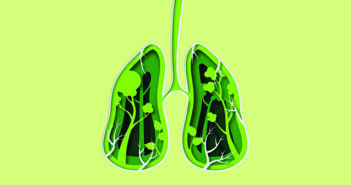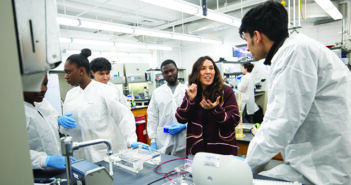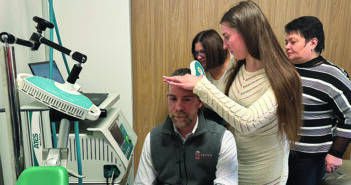An NIH-funded collaboration is kick-starting research on the No. 1 killer of humans
Across the city of Providence, an unlikely team of researchers is emerging. A developmental biologist with row upon row of tiny fish tanks in her lab. A geneticist who seeks to understand the building blocks of human life, and by extension, human disease. A cardiologist who spends hours poring over ultrasounds, looking for clues to cure his patients.
These doctors and scientists are just a few of the dozen researchers involved in Brown’s CardioPulmonary Vascular Biology Center of Biomedical Research Excellence, or CPVB COBRE for short. It’s a mouthful of a name, but one that’s fitting for its ambitious mission: to both study the root cause of diseases that affect the heart and lungs, and to find new cures.
That’s a tall order. Cardiopulmonary diseases ranging from asthma to arteriosclerosis remain the leading cause of death for American patients. They develop in a wide variety of ways, and have an equally broad range of treatments. But they often have a common connection: many cardiopulmonary diseases stem not just from problems in the heart or lungs, but in the blood vessels that support them. That’s where this group of researchers is focusing.
You won’t find veteran academic superstars in this cohort—at least, not yet. Thanks to special funding from the National Institutes of Health, all the scientists and doctors involved are junior or early-career researchers who have not yet received major grants and are just starting to get their labs off the ground. Those academics, says Sharon Rounds, MD, associate dean for clinical affairs and codirector of the CPVB COBRE, often have exciting new insights into old diseases, but few resources to study them.
“In a way, our group operates like a startup accelerator,” says Rounds, who is also a professor of medicine and of pathology and laboratory medicine. “Our strategy is to recruit strong young investigators with fresh ideas, provide them with mentors and advice, support their careers, and give them the right facilities. We also set up opportunities for these investigators to meet on a regular basis, form collaborations, and learn from one another.”
In academia, that level of organized support is a novel concept, she says. Normally the work involved in lab administration, paper submissions, teaching, and basic research creates an uphill battle for young scientists, leaving little free time to seek grants, develop new lines of study, or form key partnerships with other academics. For that reason, the CPVB COBRE takes some of the administrative weight off of researchers’ shoulders, letting them explore new ideas more freely. Most importantly it doesn’t just encourage collaborative work with peers and mentors, it requires it, building an environment where members of the center sharpen each other’s ideas.
That’s an important detail, says Elizabeth Harrington, PhD, codirector of the CPVB COBRE.
“When you’re younger, you’re intimidated, don’t have confidence in yourself; you’re so busy trying to get funded and write the next paper that the time just sloughs away,” says Harrington, who’s also the associate dean for graduate and postdoctoral studies in the Division of Biology and Medicine and a professor of medicine. “Unless you have a mentor and peers that are pushing you along, looking out for you, it’s easy to get lost in the day-to-day grind of having a successful lab.”
Only in Rhode Island
In the late 1990s, Rounds and Harrington first discovered the value of these kinds of crossdisciplinary partnerships while working together at the Providence VA Medical Center. Rounds, who is a practicing pulmonologist, had an opening in her lab for a research scientist, and when Harrington applied for the job, the two immediately hit it off.
“The thing that was really wonderful about Beth was that she brought new experience and expertise. I was pretty good at what I was doing, but was kind of stuck in a rut. She got me excited in studying cell signaling—the way that cells communicate with each other—which totally changed the direction of what I was doing,” Rounds says. “It was a real growth process for both of us. As an MD and a bench scientist, we each had different backgrounds and talents, which helped us expand our lab. We also soon realized we had a small community of like-minded people in the state that we wanted to nurture. That’s when we first applied for a COBRE award.”
“The more we talked about it, the more we realized that researchers in our small niche could be stronger as a group than as individuals,” Harrington adds. “We saw other researchers successfully do that, and wanted to see if we could make it work as well. No one else that we knew was looking in our particular area of cardiovascular pulmonary biology.”
The pair also had a geographical edge. Only 23 of the 50 states (and Puerto Rico) are eligible for COBRE funds, which the NIH provides to areas with fewer resources than, say, Massachusetts or California. States like Alaska, North Dakota, Delaware, and Rhode Island are on the list.
But Lil’ Rhody had a distinct advantage, Rounds says. Because it’s tiny, it hadn’t gotten the sheer number of research dollars as its neighbors in New England, yet it still supported world-class research and potential collaborators at the VA, Brown, Lifespan health system, and other institutions. In short, she says, it was an ideal place to bring this sort of “research accelerator” to support the careers of young scientists.
Catch-22
Qing Lu, PhD, associate professor of medicine, was one of the first scientists to enjoy support from the CPVB COBRE after it was founded in 2013. At the time she was an emerging researcher at Brown, studying the effects of cigarette smoke on the vascular system around the lungs.
“Until the past decade or so, there has been a lot of research on the lungs themselves, but not the blood vessels that bring oxygen from the lungs to the rest of the body,” she says. “Cigarette smoke can actually damage the walls of those vessels, creating tiny gaps between the cells.” When that happens, bacteria, viruses, and toxins from cigarette smoke can pass directly into the bloodstream, causing system-wide damage. Fluid from blood can also leak into the airspaces of the lungs, making it increasingly difficult to breathe.
Lu thinks her work could one day lead to new treatments for chronic obstructive pulmonary disorder, or COPD—a serious airway disease that affects more than 11 million Americans. But until joining the COBRE, she struggled to find funding. “I got small grants here and there, but only had enough to support myself and a few unpaid Brown undergraduates doing their senior thesis,” she says.
In order to establish her lab, she would have to obtain an R01, a major NIH grant that could provide enough funding to support her and several research associates for a number of years. But even being eligible to apply for the funds presented a catch-22: to get it would require presenting proof of extensive prior research, receiving other major grants in the past, and publishing research in prestigious journals—all of which is exceedingly hard to do without prior funding.
During her stint at the CPVB COBRE, however, Lu was able to mentor and support a graduate student, hire a postdoctoral fellow and lab technician, and collaborate with Harrington on new areas of work, all while getting additional training to write effective grant applications.
“It was fantastic. Being part of the center let me train more students and grow my research. It also made me a better communicator of my work,” Lu says. “I would meet weekly with peers and mentors, people who might not directly be in my area of expertise. Working with them and having to explain what I was doing really helped sharpen my scientific approach.”
After just three years with the COBRE, she had gained enough momentum to finally earn coveted R01 funding, kicking her research into overdrive. She’s since mentored students, published papers in several journals, and become an editor for PLOS ONE.
“COBRE really makes you feel like you’re stronger and more confident as a researcher. It’s a great mechanism for growth,” she says. “Without it, I probably wouldn’t still be doing this work.”
Something Fishy
The CPVB COBRE was renewed in 2018 with an additional $10 million grant, and is continuing its streak of research collaboration and mentorship—especially between academics who would be unlikely to work together, like toxicologist Jess Plavicki, PhD, and cardiologist Alan Morrison, MD, PhD.
Plavicki, an assistant professor of pathology and laboratory medicine, studies the genes of zebrafish, tiny animals that, when young, have almost completely transparent bodies. Their flesh and skin reveal a clear view of their internal organs, making them ideal for tracking how genetic changes affect their structure.
She’s spent years examining the impact of a gene called sox9b, a key element in the growth of an animal’s organs and bodily structures. Using complex genetic techniques, she’s been able to knock out sox9b in zebrafish embryos, targeting only those cells that will become heart muscle tissue.
“We wanted to know if sox9b function was needed in heart muscle for normal cardiac development,” Plavicki says, “and sure enough, when we knocked it out only in heart muscle cells, the fish had severe cardiac defects that ultimately resulted in heart failure.”
Whether those deformities were similar to any human disorder, however, was unclear, so Plavicki presented her work to her fellow COBRE researchers. When she did, Alan Morrison’s eyes widened.
“My first thought was, this is absolutely incredible!” says Morrison, an assistant professor of medicine who studies heart valve disease. “The images reminded me of a disorder called Ebstein’s anomaly,” a defect that connects two normally separate chambers of the heart. In severe cases, it can cause heart failure, arrhythmia, enlargement of the organ, and other major problems—and since it’s congenital, most of the patients affected are children or young adults.
As someone who normally sees hearts only through the fuzzy lens of an ultrasound, Morrison couldn’t stop watching the crystal-clear images. “I had never seen anything like it. I had been aware that zebrafish were used as a research model, but this was my first taste of how powerful it could be in this circumstance,” he says. “It gave me some insight about how closely related Jess’ and my work really could be, and how we could come up with creative ways to collaborate.”
The research is in its early phases, Plavicki says. If she can confirm that sox9b is involved in Ebstein’s, she’ll conduct experiments to see if the same gene causes the defect in mammals. “Mice are more closely related to humans,” Morrison says, “so if this particular gene has an effect, she would have described the first single gene to regulate the disease process, which would be really exciting.”
He and Plavicki are working toward that goal. “It was a collaboration that sort of came out of the blue, but that’s the whole point of the COBRE: to facilitate opportunities like this.” Morrison says. “The things we study are more closely related than we appreciate.”
Cell Mates
Collaborations that are focused on basic science—the sort of high-level exploratory research that Plavicki and Morrison are conducting—are an essential element of the CPVB COBRE. But the center’s ultimate focus is to find applications for that research: new ways to treat or study disease.
Beth Harrington and Corey Ventetuolo RES’07, MD, a specialist in pulmonary and critical care medicine, already have begun to develop methods that could shed light on an understudied and rare disease: pulmonary arterial hypertension (PAH), high blood pressure in the lungs. It’s caused in part by a fault in patients’ endothelial cells, which form the lining of their pulmonary arteries. Somehow those cells start to grow erratically, forming cancer-like lesions that expand into the vessels themselves.
“PAH affects all aspects of quality of life for our patients. It can make patients short of breath while doing everyday things like caring for their children, grocery shopping, or showering. And currently, there’s no cure,” says Ventetuolo, an associate professor of medicine and of health services, policy, and practice. “Existing drugs can’t reverse the lesions—they just work by dilating blood vessels so blood can flow more freely through the lungs. But these medications also impact quality of life for our patients and have side effects like flushing, jaw pain, headaches, muscle cramps, and diarrhea. Some patients have to live 24/7 on a pump to infuse medication.”
Even with these treatments, the disease can be progressive and lead to right-sided heart failure and death. “Overall long-term survival rates for our patients are still poor,” Ventetuolo says. “We have a growing list of approved drugs, but we need to do better for our patients.”
The reason PAH is not well understood, she adds, is that it’s incredibly hard to get access to pulmonary artery endothelial cells from PAH patients. At the moment the only way to obtain them is through an autopsy after a patient has died, or from lungs removed during transplantation. But those cases only represent cells that are in the end stages of the disease, not ones that are just starting to develop into lesions.
“If you’re going to test drugs in the lab that reverse disease progression, we need to be able to study cells early in the disease process,” she says. “Researchers have been trying for a long time to get any type of tissue from patients with this disease while they’re still living or before a lung transplant.”
Thanks to CPVB COBRE funding, Ventetuolo and Harrington are exploring a different approach that uses an existing routine procedure. In order to get an accurate reading of pressures within the heart and lungs, doctors must snake a catheter down into them through a major vein in a patient’s neck. On its end, a tiny balloon inflates and deflates, measuring the pressure in the right heart chambers and blood vessels. In the process, however, that catheter inevitably sloughs off endothelial cells as it slides through a patient’s arteries.
Ventetuolo and Harrington are working to harvest the cells stuck to it when it emerges. They’ve already developed a way to test each cell to confirm if they’re involved in the disease, and are creating new ways to expand those cells’ numbers in the lab.
“There’s a ton of excitement in our field about collecting cells via routine procedures like this, and harvesting them at various times during the course of a patient’s disease. Ultimately we want to know, are there fundamental differences in cells of patients who do well versus patients who do poorly? And if they’re exposed to different therapies, how might they change?” Ventetuolo says. “There’s also a sort of paradox in the disease. As many as 80 percent of patients are women, yet women survive longer with PAH than men. Do cells from women and men behave differently and can treatment with sex hormones alter the disease course?”
By working with Harrington, she says, finding answers to those questions is suddenly a distinct possibility. “I am a clinician scientist and patient oriented researcher. Beth is an endothelial cell biologist, so each of our expertise complements the other’s,” Ventetuolo says. “As a physician researcher, I can tell her what is vital for well-designed human experiments, and as a basic scientist, she can tell me, ‘here’s how to keep those cells alive, and maintain rigor in the experiments.’ Medicine and science has become so complicated, the team approach is really the best way to do it, and stands to have the greatest benefits for our patients.”
Start-Up Operation
As the CPVB COBRE program progresses, Rounds and Harrington have taken time to reflect on their own collaboration. Unlike today’s participants, they didn’t have much in the way of mentorship; just a handful of loosely connected scientists and physicians they could trade notes with over lunch. Thanks to the COBRE, however, they’re ensuring that some young cardiopulmonary researchers in Rhode Island don’t face the same struggle. Instead, these scientists have an unparalleled launchpad—one that helps grow their individual research, while creating a family of other investigators that can grow alongside it.
“COBRE really helps grease wheels for researchers in a way we didn’t have. Because of it, we’ve been able to help fund junior investigators that probably would have left the field, or at least left Brown, without our support,” Rounds says. “Instead, they stayed, flourished, and are now doing great things. It sets up a really important research legacy.”
That legacy goes far beyond Brown. In addition to supporting investigators’ labs, the CPVB COBRE is funding small pilot projects—sort of “proof-of concept” trials to test new research ideas. It’s providing support to researchers at the Providence VA, Lifespan hospitals, and the University of Rhode Island, among other places—and offering a springboard for them to successfully apply for other funding.
That alone is a thrill, Harrington says. “I get excited when I see junior investigators grow both their scientific skills and their confidence in the work they’re doing,” she says. “People who were junior investigators in our first cohort are now transitioning to mid-level researchers, and acting as mentors and role models for the next generation to come up. That’s something to be very much proud of.”
“It’s incredibly gratifying,” Rounds adds. “It sounds trite, and people say it all the time, but it’s true: the best part about being in academic medicine is seeing students and trainees mature, develop, and be successful in their own right. It’s the biggest high there is.”




